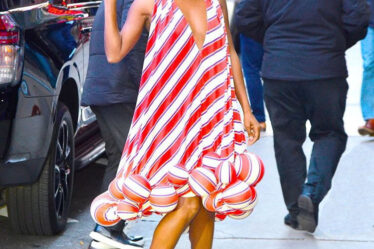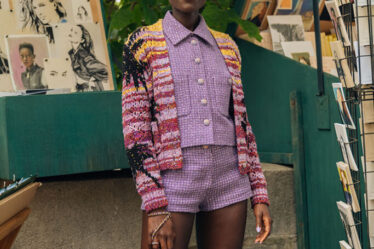PARIS — Tracey Emin’s tiny bronze bird perched high on a pole at the very centre of the Loewe show space on Friday morning. Jonathan Anderson thought of the sculpture as the analogue of a different way to look at the world, in this case, a literal bird’s eye view. It’s something he’d been considering over the last few seasons at Loewe, which he called exercises in reduction: “Putting out ideas, like archetypes that you believe in.” He said that sometimes he wanted to challenge people’s viewpoints, wanted people to wonder, how you do you wear that? Or, how do you sit on it? Or, how do you deal with it Reasonable enough questions when you consider the archetypes he offered in his latest Loewe collection.
Foremost among them was a huge circular hoop skirt, draped in pale floral georgette. “Kind of like ‘40s silk,” was Anderson’s description. He’d got the idea from prewar crinoline sets, which he’d refined. The featherlight fabric was weighed with a fine chain so it undulated while the hoop created a different movement altogether. From the vantage point of Tracey’s all-seeing bird, it might almost look like they were hovering, not unlike the leather UFO skirts-cum-tutus he showed two weeks ago in London. Also kissing cousins with the mini-shifts that were a key component of that show were the long-sleeved sequinned minidresses Anderson showed for Loewe, even mini-er here. If London was Twiggy, Paris was Edie. The dresses were the result of some complicated-sounding experiment with 3D knitting which apparently allowed the sequins to sit flat like scales. You get the feeling that is often how things happen in the Anderson atelier. “Experiments.” A couple of the little dresses had the iridescence of shells that had been crushed and mounted on georgette, so they shimmered in movement.
Another archetype was the “tourist art” of the souvenir t-shirt. Anderson was very taken with the news that previously unheard music from Mozart was recently discovered and “dropped” the way Beyoncé, Drake or Gaga might release a new album. He printed Mozart — and Chopin and Bach — on a t-shirt of white feathers. And Manet’s Little Drummer Boy, and Van Gogh’s Irises and Sunflowers too. It was a high/low moment: the feathers redolent of old couture techniques, the music and art expressions of high culture … and the t-shirt a t-shirt. Anderson compared great composers or artists to rock star pinups. “It’s like when you go to a museum or concert, it’s experiential, you want to take the moment home with you.” He said he occasionally used to wish he was a painter or a musician, because art and music last. “But the more I do this job, the more I realise fashion lasts too. Garments make you remember things.”
There was a ring attached to the invitation, engraved Loewe 1846, the year the company was founded. Obviously a ring is a circle, like the hoops on Anderson’s skirts, like the shape of his show space on Friday. Anderson was thinking in circles, but he was also thinking of the ring as a symbol of commitment. “The last few seasons, I’ve been into refinement, rather than moving on,” he said. “As a designer you are always looking to the future, and it sometimes takes a long time for the audience to catch up.” A perfect illustration of that sentiment showed in the new collection as a navy suit matching a trim jacket to a pair of the voluminous trousers scooped up to one side that Anderson’s been showing lately. It was a stand-out look, even amidst the much showier silken hoop skirts and feather T’s. “It’s a weird accomplishment,” Anderson said with some pride. “Loewe’s not actually been very good at tailoring for a long time, but we’ve been able to build the craft and manufacturing to get it right.”
There was a intriguing sidebar to Friday’s presentation in the stellar front row of Anderson’s peers. Sarah Burton, Nicolas Di Felice, Pieter Mulier, Adrian Appiolaza and Kris Van Assche all showed up. Could be a simple case of their curiosity getting the better of them all at exactly the same moment. But that’s nothing compared to what mine is doing.
Speaking of people who’ve been the subject of industry speculation as the game of musical chairs warms up again, Daniel Roseberry at Schiaparelli gave less than a second’s thought to quiet luxury and said, “Meh! Let’s do loud luxury.” But his mission was more complicated than that. As far as press and clients are concerned, he’s the Couture Kid, but he wants — needs — to impress on the world that his vision has a commercial viability above the haute, and beyond the red carpet. Roseberry has restored a sense of enduring preciousness to Schiaparelli. “People don’t buy Schiap, they collect it,” Bergdorf Goodman’s Linda Fargo told him. That gave him the idea for this new ready-to-wear collection: “Future Vintage.” He imagined what women bought now being passed to their daughters and granddaughters.
At the same time, Roseberry insisted he wanted to turn the page, keep the collectible desirability of the couture but add ease and effortlessness. He spent the last gasp of summer in Ibiza. The afterglow lingered. “I want everything to feel like you could pull it out of your suitcase. We have not done that before.” A man’s white button-down, a piqué polo and a tank top opened the show, and they certainly sounded like breezy summery staples. But Roseberry Schiapped them, made hourglass bodysuits out of them. He pointed out that all the tailoring in the collection was unconstructed, and the only embroidery was in the last three dresses, where clusters of handpainted sequins in floral motifs turned the models into radiant naiads, but still, Roseberry’s irrepressible bone-marrow maximalism meant that the overall impression was hardly subtle. One look, a zipped jacket with batwing sleeves in gleaming eelskin, had all the grandeur of a Poiret opera coat. And what might pass for his version of a tracksuit made me chuckle: a jacket in ribbed neoprene with even bigger batwing sleeves paired with matching harem pants. Extravanganza!
Roseberry insisted the collection was rooted in ready-to-wear techniques. “I did not want this to look or feel like couture, I want to make a clean break.” He mentioned pieces in salt-washed, over-dyed cotton, which sounded humble enough until Natasha Poly appeared in a stonking great trench coat. I’m exaggerating for effect, of course. Not everything was scaled up like that, but Roseberry can’t help himself. He also loves an effect. So the nautical stripes were intarsia-ed with a trompe l’oeil sarong, and a little rib knit tank ombré-ed away into sequins. And the scuffs (flats being a new development) already had sandy toes, another trompe effect. Roseberry has always taken an unholy delight in fashion’s (im)possibilities. He’s a true heir to Elsa Schiaparelli in his appreciation of the sartorial surreal. Here, for instance, there was a hyper-formal floor-sweeping tuxedo coat worn with nothing but Schiap’s new-signature anatomically correct foot-shaped slip-ons (a look that was followed closely by Vittoria Cerretti as a Bond Girl, but that one I get!). Pull that out of your suitcase.



